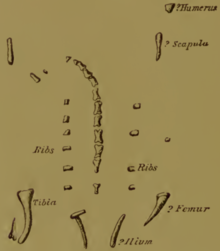Hortalotarsus
Hortalotarsus (etymology uncertain; probably "tarsus of a young bird"?[1]) is a dubious genus of extinct sauropodomorph from Early Jurassic rocks of South Africa.[2][3]
| Hortalotarsus | |
|---|---|
 | |
| Preserved portion of the holotype drawn before being partially destroyed by blasting | |
| Scientific classification | |
| Kingdom: | Animalia |
| Phylum: | Chordata |
| Clade: | Dinosauria |
| Clade: | Saurischia |
| Suborder: | †Sauropodomorpha |
| Clade: | †Plateosauria |
| Clade: | †Massopoda |
| Family: | †Massospondylidae |
| Genus: | †Hortalotarsus Seeley, 1894 |
| Type species | |
| †Hortalotarsus skirtopodus Seeley, 1894 | |
Discovery and naming
The type species, Hortalotarsus skirtopodus was named by Harry Seeley in 1894.[4] According to Robert Broom (1911), "Originally most of the skeleton was in the rock, and it was regarded by the farmers as the skeleton of a Bushman, but it is said to have been destroyed through fear that a Bushman skeleton in the rock might tend to weaken the religious belief of the rising generation."[5] Seeley however, states that most of the skeleton was lost by a failed attempt to free it from the rock by using gunpowder.[4] Some partial leg bones were salvaged.
Hortalotarsus was subsequently regarded as either a synonym of Massospondylus[6] or a valid genus belonging to Anchisauridae.[7][8] Galton and Cluver (1976) as well as Galton and Upchurch (2004), however, designated this genus a nomen dubium.[9][10]
References
- http://hellenisteukontos.opoudjis.net/2016-06-28-what-does-hortalotarsus-mean-in-latin-or-greek/
- Chapelle, Kimberley E. J.; Barrett, Paul M.; Botha, Jennifer; Choiniere, Jonah N. (August 5, 2019). "Ngwevu intloko: a new early sauropodomorph dinosaur from the Lower Jurassic Elliot Formation of South Africa and comments on cranial ontogeny in Massospondylus carinatus". PeerJ. 7: e7240. doi:10.7717/peerj.7240. PMC 6687053. PMID 31403001.
- Müller, Rodrigo Temp (2019). "Craniomandibular osteology of Macrocollum itaquii (Dinosauria: Sauropodomorpha) from the Late Triassic of southern Brazil". Journal of Systematic Palaeontology. 18 (10): 805–841. doi:10.1080/14772019.2019.1683902. S2CID 209575985.
- Seeley, H.G. (1894). "LIII.—On Hortalotarsus skirtopodus, a new Saurischian fossil from Barkly East, Cape Colony". Annals and Magazine of Natural History. 6. 14 (84): 411–419. doi:10.1080/00222939408677828.
- Broom R. 1911. On the dinosaurs of the Stormberg, South Africa. Annals of the South African Museum 7:291-308.
- M. R. Cooper. 1981. The prosauropod dinosaur Massospondylus carinatus Owen from Zimbabwe: its biology, mode of life and phylogenetic significance. Occasional Papers of the National Museums and Monuments of Rhodesia, Series B, Natural Sciences 6(10):689-840
- B. F. Nopcsa. 1928. The genera of reptiles. Palaeobiologica 1:163-188.
- R. Steel. 1970. Part 14. Saurischia. Handbuch der Paläoherpetologie/Encyclopedia of Paleoherpetology. Gustav Fischer Verlag, Stuttgart 1-87
- P. M. Galton and M. A. Cluver. 1976. Anchisaurus capensis (Broom) and a revision of the Anchisauridae (Reptilia, Saurischia). Annals of the South African Museum 69(6):121-159
- P. M. Galton and P. Upchurch. 2004. Prosauropoda. In D. B. Weishampel, P. Dodson, and H. Osmolska (eds.), The Dinosauria (second edition). University of California Press, Berkeley 232-258.